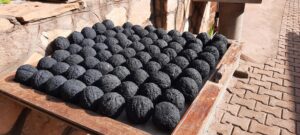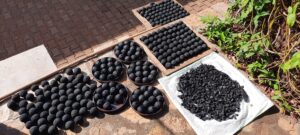- April 27, 2021
- Posted by: mukisahilda
- Category: Uncategorized
Cooking on home-made briquettes brings me memories of how I spent the peak months of Covid19 lockdown. As a work-loving person I had to invest my time and keep healthy. Whatever I was to do must be entrepreneurial, home-based and hustle-free. It must bring me joy and add value to the common good. What better idea than making briquettes that significantly reduced my domestic expenditure and carbon footprint.
I also trained children in the neighborhood and shared briquette-making video clips on many Whatsapp groups. The balls add to family income, not through sales, but by cutting on expenditure. It is important to realize that any efforts at saving make little impact until we learn to work on the constant leakage of income through avoidable spending.
The green objective behind charcoal briquettes is to use all charcoal material to zero waste so that less trees are cut. Note that a tree as well as each sack of charcoal yields 65% charcoal of which 5-10% is charcoal dust. According to UNESCO an annual yield of 12,000 to 20,000 tons of charcoal dust has accumulated into millions that could be turned into briquettes.
After rounds of trial-and-error, it was clear to me that perfecting the balls is an art rather than a science. I finally made so many strong briquettes that lasted 18 months and cut our charcoal consumption to one bag of charcoal for the entire period (down from I bag per month). Here is the recipe for a small amount of charcoal dust.
The Process:
- Wear strong plastic gloves and sieve charcoal dust through a wire mesh. Use a trowel to move the charcoal back-and-forth across the wire mesh and store away the chunks for further use. The finer the dust, the better. Save yourself the repeated mess by sieving lots of charcoal dust. A 100kg bag costs about shs. 10,000
- Measure about 10 margarine tins (0.5kg container) of charcoal dust into a basin (preferably black in color to camouflage the stain). Add starch paste such as cold porridge from cassava flour to work as a binder. You need 0.8Kg flour in 1.5L of water. A 45kg bag of charcoal dust requires only 2-3 kg of starch. Waste ripe bananas are a good alternative though they cause the wet briquettes to attract flies. The number depends on the size of the bananas. Start with about 8 big ones and keep adding to the desired thickness
- Mix one heaped margarine tin of fine clay with 1 litre of water, stir into a paste and add to the above mix. Clay works as a filler and improves heat retention but too much filler makes the briquette too heavy to absorb heat. Filer material should be at about 5-7% of quantity of the charcoal dust. Avoid sandy or muddy clay because it lacks good adhesive and heat retention properties. Additionally, the rough texture of sandy clay repeatedly wears out the gloves.
- Work the above into a thick mixture (5-10 minutes should do) that is moldable into briquettes. If the mixture turn out too soft (probably because the charcoal dust was dump or very fine), add bits of charcoal dust to desirable hardness
- Use a small plastic mould to measure the briquette mixture for uniform sizes. You may craft one from a spice container and tailor the balls to the size of your charcoal stove. For small stoves a portion that fills the palm of an adult’s hand is fine. You may need about 5 balls to fill the stove
- Hold tight your portion into a soft polythene sheet (at the neck point) and beat/compact the mixture (for about 30 seconds) into a strong ball that should not disintegrate unless it is thrown down. You will need to craft a simple four-sided piece of dry wood (about 15cm long) to compact the briquette mixture into shape. And you may craft the polythene sheet by cutting open a packaging bag (eg for bread) from grocery store.
- Dry the balls in direct sunshine for 2-3 days depending on the sunlight. The dry ball should not break unless it is thrown down with some effort
Cleanliness


Dirty work spaces depress the mind, lowers productivity and breed contempt. While you may turn your home into a small industry, your stakeholders including clients, your family and whoever else, reserve the right to an inviting home environment.
- Mark out a small area within which to work
- Sieve the charcoal dust on a plastic sheet that you can easily roll away
- Avoid littering the compound with chunks/dust of charcoal and clay, used polythene sheets, dirty gloves, buckets with dirty water, name it
- Do not stain surfaces and clothing with charcoal or clay. Wear a plastic apron
- Do not scatter briquettes to dry all over the compound
- Have clean containers where to store the balls after drying session
- Store the dry balls in clean sacks
Cooking with the balls
- Place the balls on the charcoal stove. Fill the spaces with pieces of charcoal and light the stove. Once the charcoal catches fire, you may fill the stove to the desirable level using the charcoal chunks that you sieved out.
- Should the briquettes burn out before your meal is ready, blow off the ash (using a flat pan). Use kitchen tongs to remove 1-2 of the first lot and replace them with fresh ones. Add 1-2 more pieces of charcoal to rekindle the stove
- After the charcoal burns out the briquettes continue to cook slowly. The top layer may turn ashy but the inside of the ball continues to burn for hours, gracefully steaming and simmering your food to perfection.